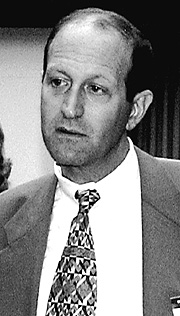
| T H E N I H C A T A L Y S T | M A Y – J U N E 1999 |
|
|
|
VRC DIRECTOR GARY NABEL'SCORRELATES OF COLLEGIALITY |
by Fran Pollner |
 |
|
Gary
Nabel
|
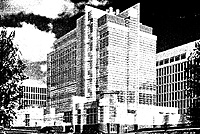 |
|
Vaccine
Research Center (to be, in summer 2000)
|
Connections and collaborations are the heart of the Vaccine Research Center (VRC), as its new director, Gary Nabel sees it and, he says, as its objectives demand. Though he is still based at the University of Michigan in Ann Arbor, where he is director of the Center for Gene Therapy and a Howard Hughes Medical Institute investigator, Nabel’s official start date as VRC director was April 11—and he’s been commuting to Bethesda, a situation that will persist until the VRC is ready for occupancy around August 2000. At that time, he will move his lab and "a dozen or so" of his colleagues—as well as some Ebola virus vaccine candidates his lab has been working on—to the VRC.
On campus, when the VRC rises whole from its scaffoldings, it will take its place as Building 40, adjacent to Building 37. In Nabel’s schematic view, the VRC would be an inner circle with connecting threads to surrounding circles representing the AIDS research enterprises at the NCI Frederick Cancer Research and Development Center; the intramural research programs throughout NIH that touch upon AIDS, vaccinology, immunology, virology, and other related investigations; the biotechnology and pharmaceutical industries; and, with perhaps less compelling tugs, other federal agencies and academia.
Within the first weeks of his "arrival" here, Nabel navigated a weekend VRC strategic planning retreat and attended the semiannual meeting of the Office of AIDS Research Advisory Council (OARAC) meeting. In his presentation and discussions with OARAC members and a subsequent interview with The NIH Catalyst, Nabel addressed an array of issues related to VRC infrastructure, its relation to the rest of NIH and the vaccine marketplace, and the characteristics of an acceptable AIDS vaccine.
Inside the VRC
Though these are the "early days of assembling the VRC organization," Nabel has a pretty clear idea of the composition of the Center. Intramural investigators at NIH whose research has bearing on AIDS vaccine research will almost certainly remain in their current labs, linking into the VRC by using its core facilities, having a postdoc presence there, and attending seminars. "Our expectation is that a minority of NIH investigators will choose to come over—I actually have not met anyone yet from the intramural program who wants to. But any who do would go through the same selection process as extramural researchers who respond to our ads." Nabel estimates that 80 percent of VRC scientists will be recruited from outside NIH. "I know it’s not a trivial thing to move, but I’ve had inquiries from people who have reason to be content where they are," he comments. Anyone recruited before the VRC is ready for occupancy can begin their research "in situ" and be placed on the NIH payroll immediately. Nabel expects that when the building does open, it will be filled with many investigators whose VRC research is already in progress.
Of the 100 full-time positions available, perhaps 15 will be administrative personnel; the remainder, he said, will be researchers, probably two-thirds of whom will be involved in preclinical (virology, immunology, translational) research and one-third in clinical trials analysis and development. Much of the production work will be conducted on contract, and clinical trial activities will take place at the Clinical Research Center.
As for the breakdown in numbers among the preclinical researchers, "it will probably be an even three-way split between virology, immunology, and translational research," he said—and they will all be "outstanding scientists, collegial, and able to look at things critically." One other desirable quality, he added, is that they "have a passion to develop an effective AIDS vaccine. Without passion and drive, it will be difficult to move beyond the many obstacles that will face us."
The VRC budget, which is $16 million this year, will have risen to about $30 million a year by the time the building is fully occupied and working at capacity, Nabel said.
Outside the VRC
The efforts of the VRC and existing NIH vaccine research will complement one another, Nabel said, noting that by no means would all vaccine work be going on in one building and citing as examples vaccine research in malaria in Lou Miller’s NIAID lab, bacteria in John Robbins’ NICHD lab, and viruses in Robert Chanock’s NIAID lab.
He also pointed to the "excellent potential for synergies" with two groups at the NCI’s Frederick Cancer Research and Development Center: John Coffin’s viral resistance program, which is exploring the molecular basis for resistance mutations and viral heterogeneity, and Larry Arthur’s AIDS vaccine program, which has "been at the forefront of whole-virus production efforts" and is exploring ways to chemically inactive whole virus and use it as an immunogen.
Nabel sees a VRC role in developing core technologies of value to all vaccine research and working with vaccine-involved NIH researchers to implement them. "We want to take advantage of opportunities that present themselves but not be distracted from our central mission, which is to advance AIDS vaccine candidates," he said.
On the other hand, the VRC will not have to create certain resources that already exist on campus and that VRC researchers will be able to tap into—such as the structural biology apparatus of the Intramural AIDS-Targeted Antiviral Program, the NIAMS Protein Expression lab, and the services of the ORS Bioengineering and Physical Science Program.
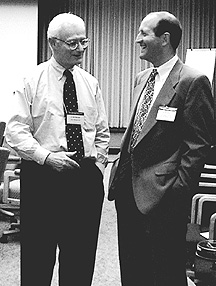 |
|
Good
Vibes: OAR director Neal
Nathanson (left) and VRC director Gary Nabel
|
On the issue of vaccine production itself, Nabel noted that NCI’s full-scale manufacturing facility at its Frederick site, which provides products for NCI clinical trials, could be a model for the VRC—should the VRC decide to develop a parallel capacity for HIV vaccine candidates. "That’s a question that we’ll probably explore further. Basically, we’re trying to create a diversified set of mechanisms, from a low-tech model that gives us the ability to manufacture on site to contracting out to creating an expanded production facility here. We don’t want to exclude any possibility." Somewhat reluctant to entrust product manufacturing to offsite entities, he said he will nonetheless pursue outside contracting aggressively, with appropriate oversight mechanisms. He anticipates extensive collaboration with the biotechnology and pharmaceutical industries to improve clinical assays and production techniques, and he plans to hold regular NIH-industry meetings and to organize a "pharm/biotech consortium" and even to "steal some people from industry on the translational side."
As for on-site animal research, the VRC has "space for more mice than people by a factor of 80," Nabel said. And although there’s no on-site primate capability, the VRC has access to NIH’s Poolesville resources. Beyond the VRC’s milieu of preclinical work, vaccine concept, and human immunology, once a candidate vaccine is ready for human testing, the FDA will help with Phase I pharmacology and toxicology guidelines, and the VRC will "hand it off" to NIAID’s newly established AIDS Vaccine Trial Network. Asked from which base the PI would come—the VRC or the VTN—Nabel replied, "I would love to have that problem to deal with. It doesn’t really matter."
Inside the Vaccine
Another problem raised during the OARAC meeting pitted the relative value of a vaccine that offered complete protection for part of a given vaccinated population vs. one that afforded partial protection for all those vaccinated. Using gay men in San Francisco as a model vaccinated population, Sally Blower, an associate professor of microbiology and immunology at the University of California at San Francisco, presented projections on the effect on HIV transmission of each of these theoretical vaccines and demonstrated that "complete protection for some is better than partial protection for all"—since the latter scenario, in the context of the false security and more risky behavior it is likely to generate, would lead to higher transmission rates. Her work was inspired, she said, by the policy question, "What degree of efficacy is acceptable for an HIV vaccine?"
Asked what he thought of the proffered choice, Nabel presented a "rationale for going forward" in either case. In one scenario, a vaccine that at least blunts the peak of infectivity could be worthwhile, and in the other, figuring out the differences in host factors between populations that react differently to the same vaccine could be worthwhile. As for prospects for a vaccine that would combine the best of both options, he said, "I can’t say I know of a vaccine candidate as of now with a good likelihood of succeeding. I think we can do a lot with just CTL [cytotoxic T lymphocyte] immunity, but to achieve a sterilizing vaccine that gives long-lasting protection, we’ve got to pursue both CTL and neutralizing antibodies—aggressively. My suspicion is that if we cannot generate neutralizing antibodies, we will only see partial protection."
He sees promise in DNA immunization, which he’s used in his lab, "not necessarily as a definitive vaccine but as an experimental tool" that allows rapid construction of multiple vectors. The discordant results observed with HIV peptides—good CTL responses with gp160 but not with nef and good humoral responses with nef but not with gp160—are typical of what he’s also seen with Ebola virus, he noted.
He asked whether looking at intrinsic amino acid sequences might not lead to the ability to predict responses to epitopes.
In the translational realm, Nabel noted the need for novel vectors for sustained expression and suggested that lentiviral constructs might be promising. In the clinical realm, comparing the vaccine responses of HIV-infected people on highly active antiretroviral therapy (HAART) with those of uninfected individuals could be "highly informative for both populations," he said.
He expects AIDS vaccine
work to be "iterative," that vaccine candidates will continually improve
over several generations. And the interest he’s observed on campus in the
VRC’s research agenda—30 to 40 PIs regularly attend VRC planning workshops—has
convinced him to formally establish an HIV Vaccine Interest Group.
![]()
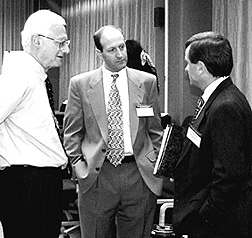 |
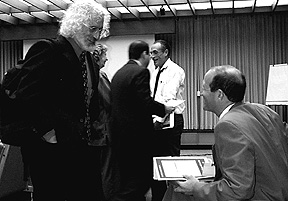 |
|
Betwixt
and Between:
As the OARAC meeting adjourns at the end of its first day, Gary Nabel
(center) continues discussions with Neal Nathanson (left), OAR director,
and James Curran (right), director of the Emory-Atlanta Center for AIDS
Research and head of the OARAC prevention science working group. During
the meeting, Nathanson noted that the 1999 budget included a 30 percent
increase in AIDS vaccine research and listed among his own research priorities
"more products in Phase I trials, more primate models, methods to
measure cellular immunity and induce neutralizing antibodies, and more
work on replicons and vectors." Curran had observed, with pleasure,
that "NIH is finally coming together (with a) goal-driven scientific
agenda for vaccine research."
|
More
To Come: OARAC
member Philip Greenberg (left), professor of medicine at the University
of Washington School of Medicine in Seattle, continues dialogue with Gary
Nabel (seated) at day’s end. Greenberg had characterized the VRC
as "halfway between a biotech company and an academic initiative."
At rear is OARAC member William Snow, of the AIDS Vaccine Advocacy Coalition,
who expressed elation over the "revitalization" of an HIV vaccine
as a research priority. "We’ve gone from last to first,"
he commented on the agenda order of delivery of working group reports.
|